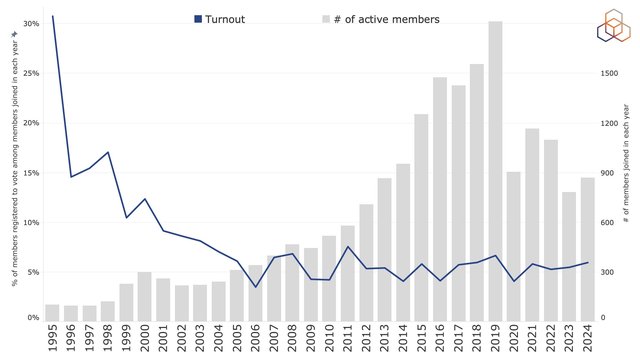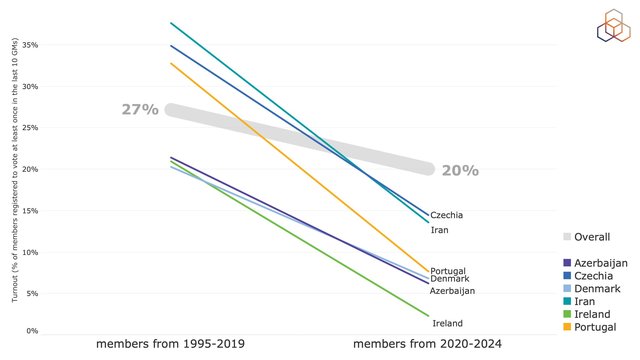This May saw two eventful votes taking place: Eurovision and the May 2025 RIPE NCC General Meeting. And just as JJ brought a win to Austria with the least amount of points a Eurovision winner got since 2015, this GM also saw the lowest voter turnout since 2015. Does that indicate a disinterest in voting in our region?
Lisbon hosted RIPE 90, the GM, and the sometimes intense discussions that came with them. There were three candidates for two Board seats and nine resolutions to be voted on, including the RIPE NCC Charging Scheme 2026.
This GM definitely stands out with a fall in voter participation. Out of 19,713 eligible members, 1,207 registered to vote and 1,039 cast their votes, resulting in a 5.3% turnout. This means this GM has the lowest number of registered voters since October 2016, the lowest number of cast votes since October 2018, and the lowest voter turnout since November 2015!

The low turnout is especially striking considering this is a May GM. While these typically attract more voters - having more hot topics to be voted on, such as the Charging Scheme and the Executive Board elections - it seems this May GM was an exception. Why might this be?
For one thing, with regards the Charging Scheme, this time a ‘no change’ proposal was up for voting that would result in members being charged the same fees in 2026 as in 2025, regardless of the outcome. As our Chief Financial Officer explained in an email to NCC announce, the RIPE NCC Charging Scheme 2025, proposed and accepted last year, was designed considering a two-year period. This is also helpful for the Charging Scheme Task Force, as they get more time to work on their proposal without disrupting their process with new changes.
As for the Executive Board elections, we had three candidates for two seats - fewer candidates than we are used to seeing in the recent GMs. In the May GMs from 2020 to 2024, the number of candidates for the Executive Board were 8, 5, 3, 8, and 6, in chronological order. The two GMs with the most candidates are also the two GMs with the highest participation. Candidates often bring supporters, likely from their own countries. This GM had relatively fewer candidates, including one from a country outside of our service region. Perhaps they didn’t do much campaigning either.
On the other hand, this GM surpassed its predecessors with the number of resolutions it had. On top of the regular three (adopting the Financial Report, discharging the Executive Board, adopting a Charging Scheme), there were six other resolutions on the Arbitration Procedure. That said, despite being many in number, none are likely to directly affect our members, certainly not as much as the resolutions that prompted the members to vote in May 2024 when we proposed extra charges for ASNs and transfer requests. Considering the lack of high stakes resolutions to vote on, it’s understandable why many members might not have felt motivated to vote this time.
Looking back at previous participation on the above graph, there are several GMs with peak voting in the last decade. These peaks are from May 2020 and May 2023, when there were matters animating the membership, and the members exercised their rights to vote on these matters.
We talked about how the community participates more actively in mailing list discussions when topics matter to them in this article we published last year on the history of the mailing lists. Among all mailing lists, conversations on Members Discuss are the most likely to reflect the topics that are typically voted on at GMs. Around the time leading up to the GM in May 2020, there were heated discussions on Members Discuss involving one of the candidates for the Executive Board. The below graph from last year’s article shows that peak in traffic in Q2 2020. The community wanted to have a say, they sent more emails to Members Discuss, and then they showed up to vote later on.

Needless to say, the RIPE NCC encourages members to vote and is happy to see peaks in voter registrations. But that shouldn’t blindly translate to “more is better”, not with mailing list traffic and not with voter turnout. This GM is likely to create a small valley on that graph. But under the right circumstances, lower participation could also support the hypothesis that "The RIPE community/RIPE NCC membership will act when it sees a need to do so," which we explored in the mailing list analysis article. Members registered for the GM when there were important matters up for voting, and they skipped a relatively chill one. After all, there are no peaks without valleys.
Country-level participation
Similar to the diverse landscape across our service region, the voter turnout also varies across countries. The decline in registrations is observed in almost all countries, but not uniformly.

Germany is still by far the biggest contributor. Their registrations also dropped, but slightly less compared to other countries with many members. Russia’s contribution seems to be slowly declining, which is also related to the shrinking membership numbers there.
Countries where the members didn’t refrain from registering for this GM and maintained a similar level of turnout increased their share in the total number of votes. Some notable examples are Italy, Czechia, Sweden, Denmark, Belgium, Austria, Norway and Ireland.
Spain is an outlying country with only 21 members having registered to vote. They historically have a low turnout at GMs, which is especially conspicuous for a country of their size. Lately, more Spanish members took an interest in voting, with around 100 members registering in the last four GMs. The consistent higher turnout in the last couple years dropped significantly at this GM. Similar to Russia, the membership in Spain is also shrinking, though not nearly enough to explain the steep drop.
Portugal’s turnout took a sudden drop after 2020. It was fluctuating around 20% between 2016 and 2020, but it fell to around 10% in the years that followed. Given the low number of voters from Portugal, it’s hard to say whether hosting the RIPE Meeting encouraged the slight increase in registered members at this GM.
Younger generations
While being tempted to analyse country-level participation after every GM, we remember the comments that country statistics might not be the most insightful. Oftentimes, when a member is from says more than where they are from. Members from different generations have become members under different circumstances, having different priorities and challenges. Their turnout at this GM, just like in previous GMs, is one way to observe how engagement differs between generations of members.
You can see below that we have more members from recent years, but the turnout of older members is higher. The discrepancy is mostly due to the high participation of our members from the 1990s and early 2000s. Despite the striking fall of the blue line on the graph, it is reassuring to notice that the turnout of members who joined after 2005 remains steady at around 5%.

Similar to the lower overall turnout, the low turnout of younger members is also not uniform across different countries. As we grapple with the issue of our community ageing, identifying the countries where participation from younger members is especially low might provide crucial insight, despite doubts around the usefulness of country-level stats.
Our host for this GM is one such country. There are 26 active members from Portugal that joined in the 2020s, only two of which have registered to vote at least once.
When we separate the members from this decade, we see that their turnout at the last 10 GMs (since October 2020) is 20%, as opposed to the 27% turnout from the rest of the membership. The gap is more pronounced in some countries. Ireland especially stands out with only 2% of their members from the 2020s having ever voted.

Low turnout
A whole article, ruminating on low turnout, dissecting it from many angles. Why? Because this is about legitimacy! General Meetings are an essential part of our governance. They ensure we have a well-run RIPE NCC that members can trust. It’s only natural that lower participation in our governance raises concerns. Understanding the reasons behind members’ reluctance to vote at this GM can help us to address these concerns.
The efforts we’ve taken to increase voter turnout (from moving to fully remote participation, increased engagement opportunities with Board candidates, greater transparency on key issues, and more extensive communications in many channels) are themselves worthwhile, and most of them have come at the suggestion of our members. But as drivers of turnout, they seem to be less effective than controversies, unpopular decisions and price increases in bringing out the vote.
This GM presented the members with an opportunity to vote on a relatively small number of Board candidates and a batch of resolutions that were about ensuring good governance rather than making dramatic changes. The result? Fewer votes than last year, but a RIPE NCC that is stable and strengthened with the input from (some of) its members. We look forward to not necessarily high, but broad participation in future GMs - including from newer and younger members.




Comments 2
Arash Naderpour •
Thank you for this thorough analysis of the GM. It's valuable to see such transparency around participation trends and governance dynamics. The report notes that country-based statistics might not be the most insightful, yet a lot of the analysis is framed around them. How NCC balances the use of this data while acknowledging its limitations? On future engagement strategies, are there plans for new approaches like local language content, shorter explanatory videos, or regionally focused outreach to connect better with underrepresented or newer members?
Ilke Ilhan •
Thank you for your comment! Country-level participation is only one aspect - it is insightful, but might not be the most insightful angle in every case. We are careful not to rely solely on country-level participation in our analyses, while recognising when it adds value to do so. This GM, we chose to highlight it more due to the low turnout. The drop in turnout wasn’t uniform — participation from some countries shifted more noticeably compared to earlier GMs. We thought it is important to point out the disproportionate change in countries’ turnout this time. Another reason has to do with reflections on community involvement. Identifying the countries with low participation, and especially from younger members, is helpful as we deal with the issues around our ageing community. All that makes your suggestions on engagement very valuable. We are working on making our services more accessible in different languages, creating more explanatory content, and connecting with you in our regional meetings.